In 1715 the Scottish architect, Colen Campbell, launched his campaign for a return to the purity which he believed to have been the quality of the antique. In the preface to the first volume of his Vitruvius Britannicus he praised Andrea Palladio and placed great emphasis on simplicity and on proportion.

Throughout much of the eighteenth century the entrance hall (and to an extent, the staircase too) was regarded as being a semi-external space. This had a bearing on both the furnishing of the room and the colouring of the walls. Note, for example, how the seating in the images above is not upholstered and the decoration fairly sparse.
In the larger houses this external feel could be emphasised by the architectural treatment of the hall. The Stone Hall at Houghton is perhaps the best-known example, where a full complement of external architectural details: stone walls, pedimented doorcases, sculptural reliefs, niches and false windows is included. At Wolterton Hall, also in Norfolk, built by Thomas Ripley in the mid 1720s, the use of external features has been taken to such an extent that the stairwell looks as though it has been turned inside out, with entablatured windows looking into it. At the slightly smaller Davenport House in Shropshire the walls are heavily rusticated giving a very strong feel of stone.2
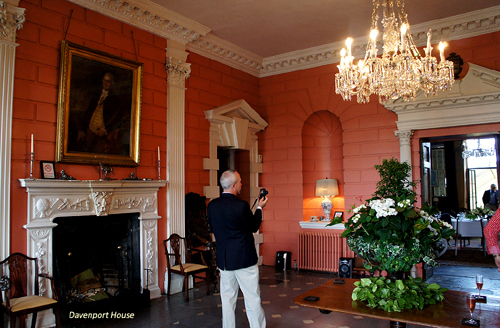
Analysis of many eighteenth century houses has shown that a neutral stone colour was frequently employed on the walls. This was fortunate from the point of view of economics, as fashion decreed that what was generally the largest expanse of wall area was covered with the cheapest paint colour – one of the so-called
Common Colours. The paint was sometimes sanded1 to suggest stone.
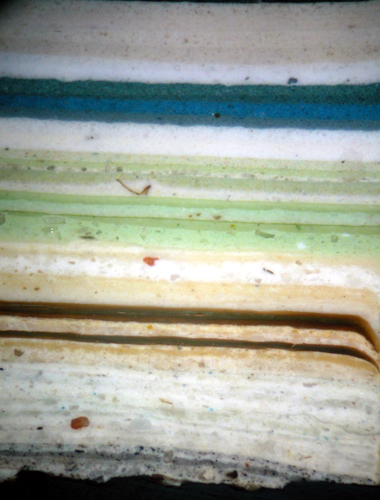
Note that after the first two schemes of Lead Colour (grey) much lighter stone colours were employed
The transition from darker to lighter colours has been seen clearly in the stratigraphy when looking at the paint of several houses of the early eighteenth century. As will be seen below, for example, the evidence suggests that the entrance hall at Roehampton House (1712) and the South Hall at Wilbury (1710) both adopted paler stone colours in the 1730s having originally been painted in darker colours of different kinds.
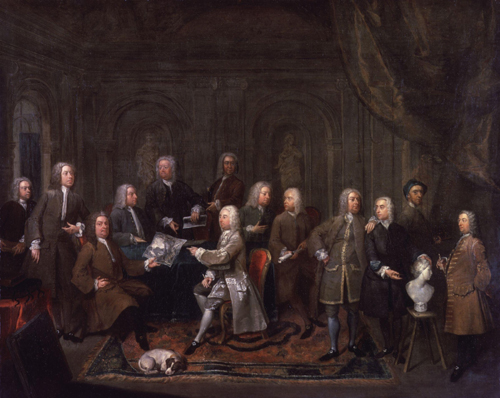
Whereas at the beginning of the century darker colours, such as olive green and drab, had been considered fashionable and finishes tended to have a high level of sheen, within thirty or forty years there was a gradual introduction of a lighter palette and often in a more matt finish.
Analysis of the painted surfaces in a number of eighteenth century buildings – ranging from those in London terraces to substantial country houses has confirmed the widespread use of stone-coloured paint in the entrance hall.
The following examples show what was found when examining the painted decoration in the entrance halls of a number of eighteenth century buildings of varying types:
A house in Queen Anne’s Gate – 1705
The panelling in the entrance hall was painted in a stone colour on the first two occasions. This was changed to a grey colour on the third to fifth times that the area was painted. Stone colour was readopted and employed until the ca.1830s.
Wilbury House, Wiltshire – 1710
The dark colours on the panelled walls of the South Hall were replaced by off-white in the mid 1750s. At this time the original panel mouldings were prised off and the walls made flush. Papier mâché ornaments and plaster medallions were also introduced as part of the new look.
Roehampton House, – 1712
The first two schemes were in a Lead Colour, a bluish-grey produced with charcoal black3 pigment in the lead white base.
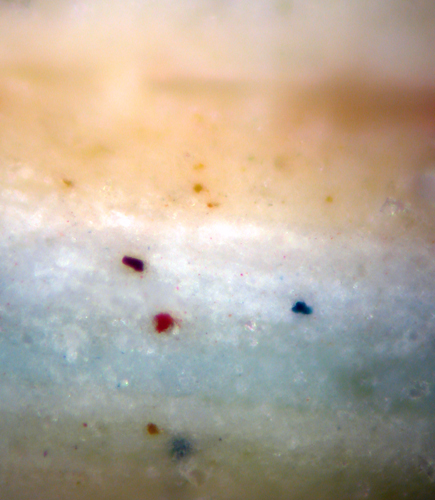
The components indicate that this is the French Grey scheme visible in 1770
Fawley Court, near Henley – ca.1720
The first four schemes in the entrance hall at Fawley Court (originally formed in ca.1720) were in a plain stone colour. Of the scheme applied in 1770 there is a description in the diary of Mrs Philip Lybbe Powys who says that it was
“a very noble one; round it statues on pedestals, some fine ones large as life. It’s stucco’d of a French grey.”
This was the fifth decorative scheme and it was very exciting to be able to identify it in cross section from the components.
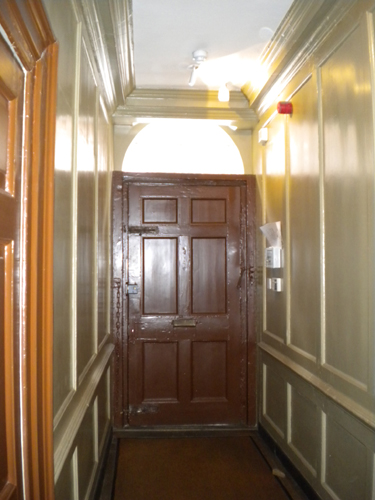
36 Craven Street – 1730
Throughout the 18th century the panelling of the entrance hall and stairs of Benjamin Franklin’s house was painted a mid-stone colour and given a thin uniform coat of a brown tinted glaze. The intention behind this was to produce a shiny / light-reflective and wipeable surface. Lighter stone colours, without a glaze were applied in the 19th century.
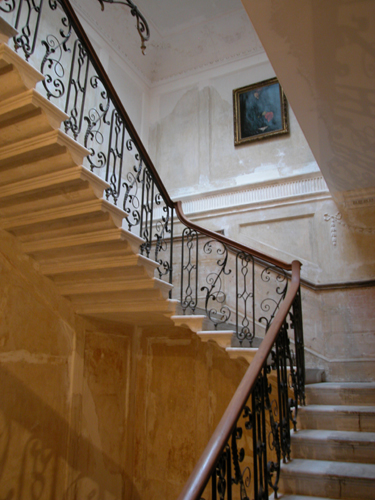
The Terrace, Richmond, Surrey – 1769
The first two schemes in the entrance hall passage were carried out in mid stone-coloured paint. The name of Sir William Chambers had been mentioned in connection with the building, but this is generally dismissed.
In 1771, Chambers wrote to a client, for whom he was building a house in Berners Street:
“…if you have any Particular fancy about the Painting [of] your principal Rooms be pleased to let me know [.] my intention is to finish the whole of a fine stone Colour as us[u]al excepting the Eating Parlour which I purpose [sic] to finish pea Green with white mouldings & ornaments.”
Basildon Park, Berkshire – 1776-1783
The first two schemes on the walls of the staircase were carried out in pale stone colours. A slightly earlier set of proposals for the building of Shardeloes, in Buckinghamshire, survives in which the effect would have been very similar to the initial scheme found at Basildon Park:
The deal work [joinery] & stucco to walls &c. to be painted three times in oyl of a light stone colour 4 . The iron work [stair balusters] to be painted of a sky blue & the doors of a chocolate colour.
Such a colour was still very much the convention for the walls of entrance halls and staircases in the first half of the nineteenth century, when the hall continued to be regarded as a semi-external space. A recommendation from a contemporary work on house-painting gave:
“An Excellent Colour for Entrance Halls and Staircases. – White, stained with spruce ochre5, umber6 &c., which will produce what is termed a warm stone colour. Its appearance is cheerful, and texture solid.”
Notes
1 Particles of sand were sometimes strewn onto the paint while still wet giving the texture of stone. In later years ready-mixed sand-textured paint came to be used.
2 The fact that the walls are rusticated gives a clue to the original colour. Although I have not taken samples from the house I cannot help but feel that the use of red is at odds with the architecture.
3 A pigment produced from the burning of beech or willow charcoal. It tended to imaprt a bluish-black tint to white.
4 Light, or pale, stone colour implied off-white. The grinding of lead white into linseed oil. produced an off-white colour rather than white.
5 Spruce ochre was generally considered to be a dark or dull yellow ochre.
6 Raw umber is a natural brown pigment with a high proportion of iron and manganese oxides.
We can be found here


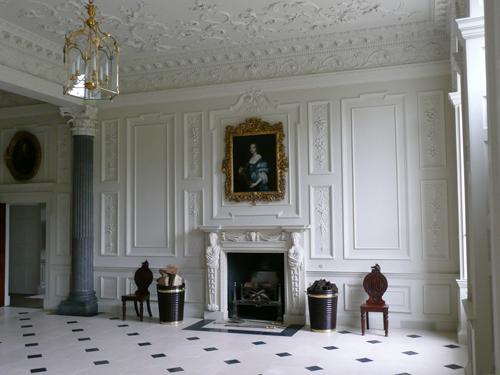
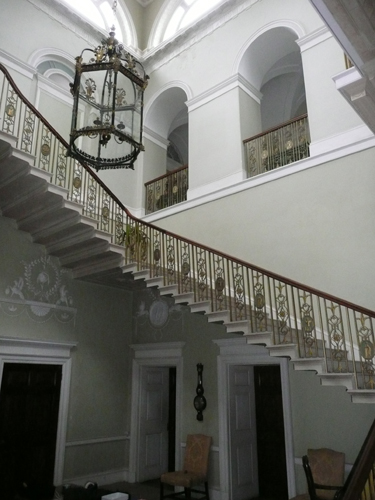










No comments yet. Be the first!